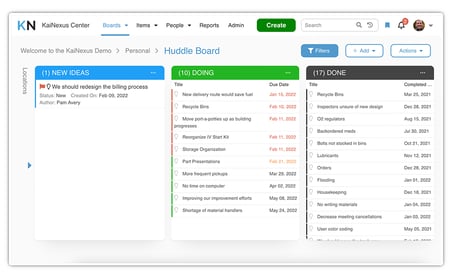 We recently came across a great article in IndustryWeek by Dan Markovitz, president of Markovitz Consulting, a faculty member at the Lean Enterprise Institute, and a teacher at the Stanford University Continuing Studies Program. His book “Building the Fit Organization,” received the Shingo Research Award.
We recently came across a great article in IndustryWeek by Dan Markovitz, president of Markovitz Consulting, a faculty member at the Lean Enterprise Institute, and a teacher at the Stanford University Continuing Studies Program. His book “Building the Fit Organization,” received the Shingo Research Award.
Check out a recording of Markovitz's webinar on "Building a Fit Organization" here.
The article is titled, “Three Reasons Why Visual Management Boards Fail.” In it, Markovitz lays out three critical points of failure; unprepared culture, lack of standard work, and undefined process-oriented metrics. “Sadly, as often as not, these visual boards turn into unattractive wallpaper, unused, unloved, and out of date,” he said. “The reason that they fail to fulfill expectations is that the necessary groundwork hasn’t yet been laid.”
Markovitz has some excellent suggestions for combating each of these issues and the article is really worth the read. One additional way to avoid these failures is to implement a software solution that supports continuous improvement and visual management. Here’s how it addresses each of the common points of failure.
Culture
Organizations that practice continuous improvement ask their employees to make a pretty big shift in thinking. Problems must evolve into opportunities. Blame must give way to active problem solving. Giving employees access to an easy way to capture and manage these opportunities for improvement goes a long way to supporting this cultural adjustment. It also shows how committed the organization is to setting the stage for positive change. An additional benefit is that a shared language arises around the technology and improvement work. This makes it much easier for everyone to be on the same page.
Standard Work
It is simply not possible to visualize improvement if you don’t know where you are starting from. Standard work is the foundation on which all improvement rests, so it makes sense to have a unified and accessible system in which to store standard work documents and history. Each PDSA cycle that results in a new Standard is fully documented and available to the entire organization. Better yet if it is the same solution that will be used to improve those standards.
Process-Oriented Metrics
To be useful, the visual management approach must be based on a set of measurable objectives that the organization wants to achieve. Process improvement software helps organizations align the goals of each person and team with the strategic objectives of the organization as a whole. It also makes it easy to track the results of each improvement. What’s more, it makes it easy for leaders to visualize the progress of improvement work itself. They get a view into the health of the organization and can readily identify, recognize and reward individuals who are making good things happen.
Markovitz’s article concludes, “Rushing to create a visual management system will result in visual clutter that does nothing to help workers or managers improve the way work is done. If you take your time establishing the right foundation, you’ll be rewarded with visuals that help people do their jobs better.” We couldn’t agree more.



Add a Comment